There are a list of tools of the [historical costuming] trade that I want to have, but don’t yet have.
Some I don’t have because I haven’t had a project where I desperately needed them yet, some I don’t have because at the moment they simply can’t be bought (18th century ruffle punches, replica or real), some because I can’t afford them, and many, many because they are so hard to get in New Zealand, and so ridiculously expensive to have shipped in (and I don’t enjoy shopping over the internet, won’t use pay-pal, and like to see and handle things before I buy them).
This week I got extremely lucky, and was able to tick one of my biggest wishes off my list (and for an extremely reasonable price). I’m now the proud owner of not one but two hat blocks!
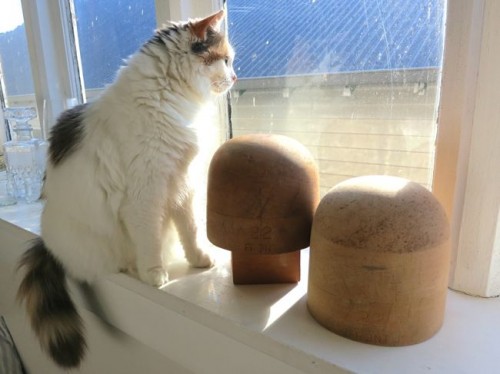
Aren’t they gorgeous? Aren’t they things of beauty and joy forever?
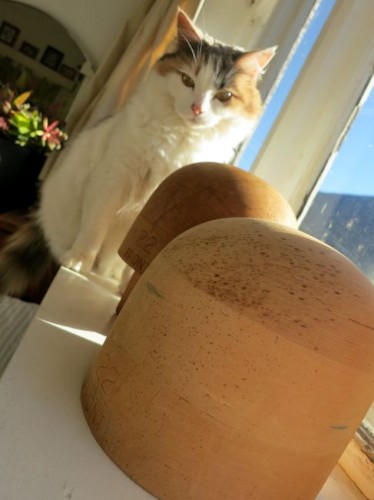
Felicity thinks so (actually, she’s kind of indifferent to them, but since I put them on her favourite windowsill in the morning sun she was willing to pose with them).
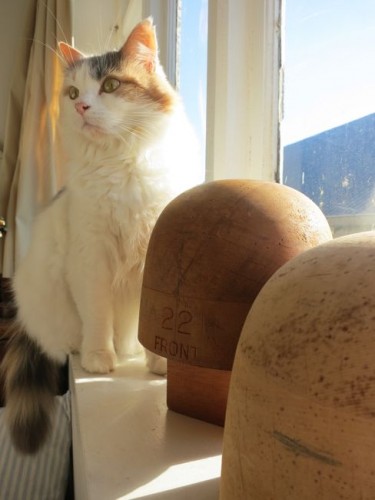
I found them at the incomparable Three Buckets Full, where the wonderful proprietor had them marked as NZ$60 each, but sold me both for NZ$100 (I buy a lot from her, and bring lots of other people who also buy a lot from her, so she likes me). Seeing as they regularly go for NZ$150 online, and are over NZ$200 new, plus shipping, from the UK, it was a spectacular deal. The hat blocks were both made by Williamson of Dunedin, who (as best as I can determine) made hat blocks up until the mid-20th century.
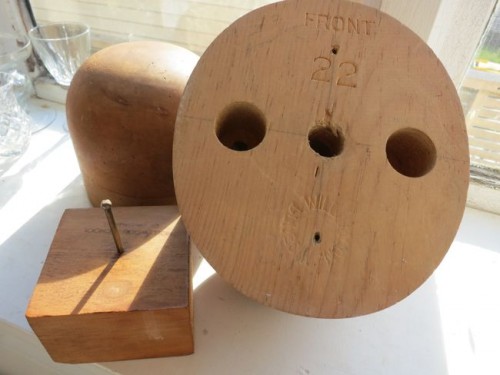
In addition to the two blocks, there is a small square block stand for the blocks to sit on, which gives another clue to their provenance. The hat-blocks were used by the Hollywood School of Dressmaking – how glamourous!
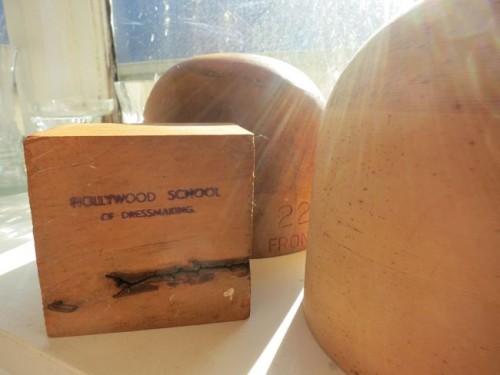
I can’t find any information about the school itself, but every once in a while sewing items marked ‘Hollywood School of Dressmaking’ turn up on Trademe (NZ’s answer to e-bay). They mostly belonged to the seller’s mother, aunt or grandmother who was a seamstress, and would have learned in the period between 1930-60.
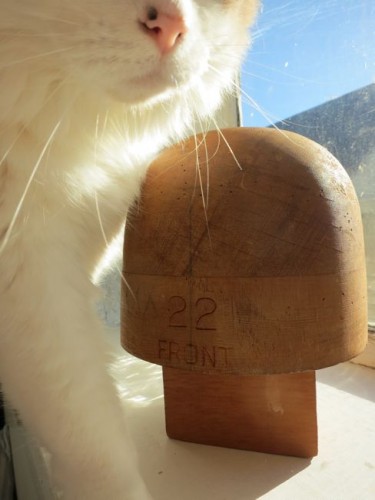
Disappointingly, both of my hatblocks are the size 22″. Luckily that is my size, but I would have preferred to have two different sizes, to give me more scope in shaping hats for other people.
One of the hatblocks has had a bit of damage from borer in the past, but I’ve had a good look at it, and am sure it’s very old damage, and won’t affect my shaping hats.
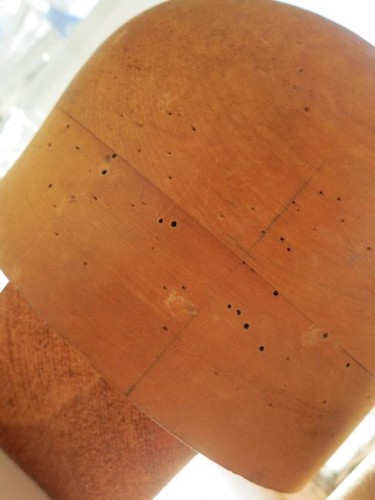
The blocks are marked with front and back – you can see how the back of the block curves in, like the curve of a head. Perfect for low-sitting hats like cloches!
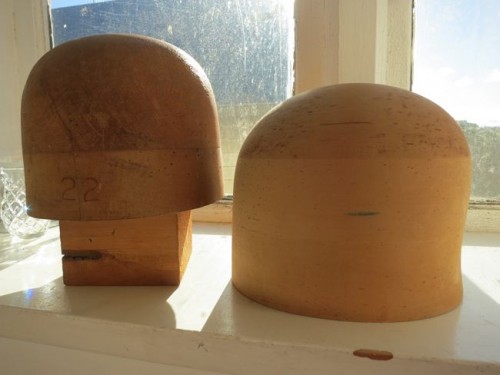
Now I just need to find the perfect place to store them, since the windowsill probably isn’t ideal. And I need some felt and straw hat bases, so I can begin making hats!
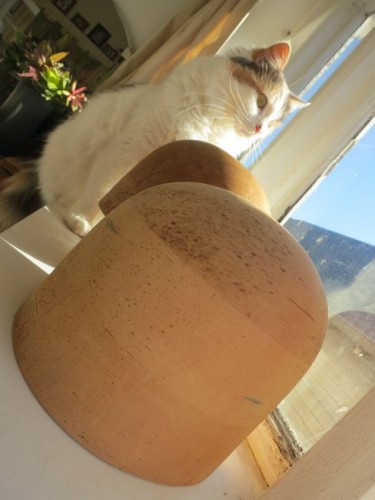
And when that happens, I’ll need to find a way to keep them away from Fiss, because she may not find the blocks interesting, but I bet she would find closely shaped wool and straw felt on them most enticing and scratchable!

I’m so glad you got them in your size! I was afraid near the end that you would say they weren’t. At least with two of them in the same size you can try to make two different hats at the same time–when you get bored with one, you could work on the other!
Oh, I am so pleased for you! “Heads”! Now it makes sense. What fun, and what lovely things to have. We had one once, but my mother threw it out – she’s the reason I’m a hoarder! My great grandmother made hats for Ballentynes (local big store) when she was young, and her daughter was working as a milliner before she married. Not something I have ever done, but fascinating.
Felicity’s face in that third picture is probably my favorite ever! How exciting that you were able to score these blocks; I’m looking forward to seeing what you make with them!
Hi Leimomi,
If you want to increase the size of your hat blocks from 22″ (the average head size is 22.5″) the milliner’s trick is to block an old and unwanted felt hat to act as a layer to build up the block size. You can block 2 or three old felt hats, one on top of the other, to increase the block size, mindful that if the wooden block has intricate lines or detail these may be compromised by using the felt hoods.
Those are beautiful photos – and that’s definitely a score! Now I’m curious to see how exactly these would be used. 🙂
How perfect! What great luck! Can’t wait to see what these enable in the future!
Those are basic head shaped blocks in extremely nice shape. The holes are not from insects, but because the previous milliner used pushpins ( or soemthing like them) to pin her work and/or cords in place. If you plan to use traditional methods, you’ll be doing the same.
This is the optimal shape, if you have only one, because with it you can do a myriad of shapes. The second most useful being one with a flat crown – which is also the easiest to make ( just find someone to cut the proper oval for you and sand and seal it.)
I also would not fret about the size. It’s better to have one on the small size ( and yours is, as the most common size is 22.5″ and the vast majority of people are 22 – 23, unless they have thick hair, dreads, etc.). with the addition of a hat stretcher you can stretch it quite a bit larger before you add a head size band or brim. You can usually find them for not too much money because most people are focused on getting that block, and may think the stretcher is just for finished hats.
If you don’t have Denise Dreher’s book, From the Neck Up, that should be next on your list. I own most of the millinery books that are in print, and this one beats them all, because it teaches professional techniques for a wide variety of applications.